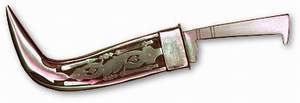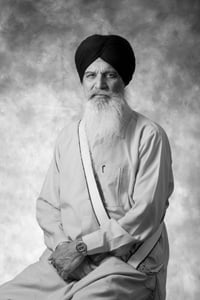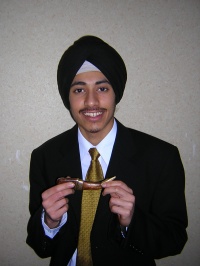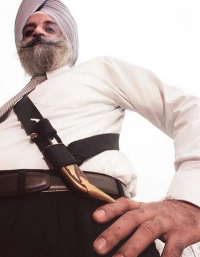Kirpan
Guru Gobind Singh told his Sikhs at the Baisakhi 1699 Amrit Sanchar to wear a Kirpan at all times as an article of defence together with the other 4 Kakars. This injunction was in order to protect the weak from tyranny, to maintain a state of harmony and security and to allow the universal right of all beings to live their lives in a peaceful and stable environment.
A baptised Sikh, better known as a Khalsa Sikh is a "Sant-Sapie" - a Saint-Soldier: A Saint first and then a soldier. Also, the Khalsa is "Akal Purakh de fauj" - the Army of God. The kirpan is the symbol crystallising the fact that when a Khalsa joins this army, he or she has left behind the docile environment of subservience and subordination and has joined the fearless and brave defence force of Guru Gobind Singh. The recruits of this army have a duty to fight for justice and against oppression of any weaker person.
| Dehi Shiva Bar Mohe Ihe (O God, give me these boons) Shubh Karman Se Kabhun Na Taron (Never shall I shirk from doing good deeds) |
| by Guru Gobind Singh |
While the bravery of a Khalsa can never be questioned as history is witness to the steadfastness of their resolve. (see Battle of Saragarhi). However, under no circumstances is the Sikh allowed to use force in aggression. Bhagat Kabir makes this very clear in the following verse:
| Kabeer, it is tyranny to use force; the Lord shall call you to account. When your account is called for, your face and mouth shall be beaten. ((200)) |
| SGGS page 1375 |
Further Details
The Khalsa is expected to live by the high moral standards of the Sikh Gurus at all times which includes such things as abstaining from smoking, drinking and other intoxicants, performing daily prayers and always maintaining the distinctive physical symbols of Sikhism on their person. The most noticeable of these being uncut hair and carrying the Kirpan.
This injunction to wear the 5Ks appears in the Reht Maryada (The Official Sikh Code of Conduct); "Have, on your person, all the time, the five K's: TheKesh (unshorn hair), the Kirpan (sheathed sword), the Kachhehra (drawers like garment), the Kanga (comb), the Karha (steel bracelet)." (Reht Maryada, Ceremony of Baptism or Initiation, Section 6, Chapter XIII, Article XXIV, paragraph (p))
The Reht Maryada does not specify the length of the Kirpan or how it is to be worn by the devotee. Kirpans can be anywhere from 3 foot swords carried by Sikhs on religious festivals, marriages and parades, to a few inches in length. They can either be worn over ones clothing or under the clothing. The Kirpan is usually kept sheathed except when it is withdrawn from it's casing on such occasions as consecration of the ceremonial sweet pudding distributed during religious ceremonies.
Guru Gobind Singh in the following verses instructs the Sikhs to only draw the sword as a last resort and in response to an attack by the aggressor:
| When all other methods fail, it is proper to hold the sword in hand. (22) |
| Dasam Granth – Zafarnamah |
Also Maharaj in Bachitar Natak tells of the incident where he is fired upon before he responds thus:
| Hari Chand, filled with rage, drew out his bow, he aimed and shot his arrow, which struck my horse. When the edge of the arrow touched my body, it kindled my fury. |
| Dasam Granth page 148 |
The Kirpan is one of the Five Ks, of the Khalsa Sikhs. The word kirpan has the literal meaning of weapon of defence; ("Kirpa" means "mercy" and "Aan" means "bless"), as opposed to the talwar, a weapon of offence.
Typically made from iron, kirpans range in blade size from 3 inches to over 3 feet and Sikhs in the west wear kirpans of about 3.5 inch blade size. Most Sikhs wear the kirpan under their clothes and most people observing a random Sikh would not be aware that they were carrying a kirpan. To the Sikhs, it is a highly important religious symbol; it is rarely used as a weapon. Nevertheless, the requirement that baptised Sikhs wear the kirpan has caused problems for believers in many areas, especially where the custom clashes with local laws against carrying weapons. In cases where safety regulations conflict with wearing the kirpan, such as boarding an airplane or entering a prison, Sikhs reluctantly comply with authorities.
To suggest that the Kirpan is a weapon is both incorrect and misleading. If it was instituted as a weapon, then would Sikhs not be expected to carry guns today? Guns were in common use during the time of Guru Gobind Singh. If the Kirpan was purely a soldiers weapon for Sikhs, than why do they not also carry a shield as well or other armour? Why do modern armies and soldiers carry swords on ceremonial occasions? Because it is symbolic of their military tradition and heritage. In the same way Sikhs carry the Kirpan at all times because it is symbolic of their religious tradition and heritage.
A Sikh should never use the Kirpan in anger or for a malicious attack. However, a Sikh may use it in self-defence or to protect a person in need. Some Sikhs choose to learn the art of Gatka. This is a martial art devised by the Sikh Gurus that uses circular movements to effectively swing a kirpan.
Legal Cases
from www.warwickshire.police.uk
There are two main areas where the Sikhs come into potential conflict with the law of the land;
The first is the wearing of a turban, whilst riding a motor cycle. Under the Motor Cycles (Protective Helmets) Regulations 1980 there is a specific exemption for Sikhs wearing turbans,
Secondly, is the Kirpan (Dagger). Some police officers may believe Sikhs carry the dagger as an offensive weapon. Under the Criminal Justice Act 1988, which deals with carrying articles with points or blades, there is an exemption, if the person is carrying the item for religious reasons. There is however, no specific exemption under the Prevention of Crimes Act 1953. The person carrying the offensive weapon would have to show that they had a reasonable excuse. The inference being that the carrying of the Kirpan for religious reasons would fall into this category.
In practice, Sikhs who carry the Kirpan will often only carry a very small knife, which could be described as ornamental rather than the original version, which, therefore, complies with their religion.
From www.sikhcoalition.org see this site for more details:
Judge Painter in Ohio, concurring in a judicial opinion in 1996 wrote, "To be a Sikh is to wear a kirpan--it is that simple.")
Regulations in the UK
Is It Legal To Carry A Kirpan In Britain?
Yes it is! Under the Criminal Justice Act 1988 (section 139) and Criminal Justice 1996 (section 3 and 4) allows anyone to carry a blade exceeding the length of 3 inches for religious, cultural or work related reasons. The Criminal Justice Act and the 2003 Religious Discrimination Act safeguards the Sikhs to carry the Kirpan.
The following is a record to discussion held in the House of commons on 22 March 2005:
From www.publications.parliament.uk
David Taylor: To ask the Secretary of State for Foreign and Commonwealth Affairs what his Department's policy is on the wearing of the kirpan by Sikh employees. [221672] Mr. Alexander: The Foreign and Commonwealth Office's (FCO) commitment not to discriminate unfairly on the grounds of religion or belief is set out clearly in our equal opportunities policy. This states: "All FCO staff are entitled to be treated with respect. No staff should be exposed to unfair discrimination, including harassment, bullying or victimisation on any grounds, particularly gender, family status, race, disability, religion, faith or sexual orientation." The FCO does not have a specific policy on the wearing of clothing or items associated with particular religions. This includes the kirpan. However, in line with our equal opportunities policy, all employees are free to practice their religion. The FCO has taken a number of steps to address discrimination on the grounds of religion or belief. These include: diversity training for all staff, diversity objectives for all staff, provision of prayer rooms, and flexible working which enables staff to pray during religious festivals.
Regulations in Canada
In the 2006, the Supreme Court of Canada's decision in Multani v. Commission scolaire Marguerite‑Bourgeoys, the court held that the banning of the kirpan in a school environment is against Canada's Charter of Rights and Freedoms. The issue started when a 12 year old student dropped a 20 cm (8 inches) long kirpan in school. School staff and parents were very concerned, and the student was required to attend school under police supervision until the court decision was reached.
In the News
Dagger is religious symbol, not weapon, court rules Doctor's conviction tossed out on appeal
Saturday, January 4, 1997 BY KRISTEN DELGUZZI The Cincinnati Enquirer Dr. Harjinder Singh can once again wear his kirpan, a small, dull knife that represents justice for all in the Sikh region.
For the first time in more than two years, Harjinder Singh on Friday tucked into his waistband holster the tiny, dull knife that, to him, represents honor and justice for all.
The Symmes Township man had not worn the two-sided knife, known in the Sikh religion as a kirpan, since his 1994 arrest and conviction for carrying a concealed weapon.
But Friday, after he learned that a local appeals court declared the kirpan a protected form of religious expression and threw out the case against him, Dr. Singh was once again wearing the symbol of his faith, though not in the same fashion he did before.
I could not practice my religion for two years, the 48-year-old veterinarian said with a sigh. It just messes up your whole psyche, your whole life. It's torture. We don't live in Russia. This whole thing has been very oppressive.
If he were not so disheartened at having to reject a symbol of his faith, he would find irony in the meaning of the icon, for which he says he endured hours of humiliation and pain at the hands of Cincinnati authorities.
But after years of court battles and thousands of dollars in legal expenses, he sees only red.
The judge and the prosecutor - they wanted to win it one way or another, so they perverted the court proceedings, Dr. Singh said. This was basic harassment.
His legal troubles began when he refused to answer questions during a civil lawsuit hearing at the Hamilton County Courthouse. The judge ordered him taken into custody for contempt of court.
Deputies handcuffed Dr. Singh and, during a search at the justice center, found the kirpan - with its 2-inch blade - stitched to the waistband of his pants.
He says he tried endlessly to explain - first to deputies; later to prosecutors, judges and juries - that the kirpan was not a weapon but one of five symbols his religion required him to wear at all times.
Worldwide, the kirpan, along with a bracelet, an undergarment, a comb and long hair, are recognized symbols of the Sikhism, which has 18 million followers, including 150,000 in the United States. Canada, England and India are among the countries that recognize the symbols, Dr. Singh said.
It's basically accepted around the world, he said, but it is not acceptable in the city of Cincinnati.
During his first trial before Municipal Judge Jack Rosen, jurors could not reach a verdict. But a second jury convicted Dr. Singh after former judge Albert Mestemaker told jurors not to consider the religious grounds as a defense.
Dr. Singh appealed the conviction, claiming it violated his constitutional rights, as well as the federal Religious Freedoms Restoration Act, which prohibits governments from placing undue burdens and restrictions on religious customs and practices.
In a unanimous opinion written by Judge Robert Gorman, the Ohio 1st District Court of Appeals in Cincinnati agreed.
References
External Links
- sikhhelpline.com
- pb.rcpsych.org - Caring for Sikh patients wearing a kirpan
- saldef.org
- uofaweb.ualberta.ca - A Summary of the Kirpan Case
- Becket Fund helps broker settlement allowing kirpan
News
| These articles deal with Sikh's Five ks |
|
Kesh (uncut hair) -|- Kara (bangle) -|- Kanga (small comb) -|- Kachera (under garment) -|- Kirpan (sword) |




